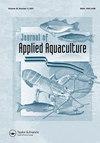Total replacement of dietary fish oil with vegetable lipid sources influenced growth performance, whole body composition, and protein retention in Nile tilapia (Oreochromis niloticus) fingerlings
IF 0.8
Q3 FISHERIES
引用次数: 4
Abstract
ABSTRACT Several reports show that aquaculture is the fastest food-producing sector globally, contributing nearly half of global fish production from all sectors. However, there has been a steady decline in production of fish oil (FO), which supports intensive aquaculture production. This has resulted in variable but generally increasing prices of FO. Finding suitable alternatives to scarce FO is essential for aquaculture sustainability. Therefore an experiment was carried out to investigate the influence of complete FO substitution with vegetable oil (VO) in the diet of Oreochromis niloticus fingerlings on growth performance, whole-body composition, and protein retention. Four isonitrogenous (30% crude protein), isolipidic (8% crude lipid), and isocalorific (17 MJ kg−1gross energy) basal diets were formulated as follows: a control diet was formulated to contain 5% FO and labeled FOD (fish oil diet), and three other diets were formulated and labeled SOD (soya oil diet), GOD (groundnut oil diet), and POD (palm oil diet); they contained soya oil (SO), groundnut oil (GO), and palm oil (PO) respectively as total replacements for FO. Triplicate O. niloticus fingerlings (N = 120, n = 10, 1.20 ± 0.03 g, mean weight ± SD) were randomly allocated to one of four experimental diets. Fish were hand-fed to apparent satiation twice daily for 63 days. The result obtained from the experiment revealed that dietary lipids significantly influenced growth performance and nutrient utilization of O. niloticus (P < 0.05). The fish fed POD had the least weight gain (WG) and highest feed conversion ratio (FCR) compared with fish fed FOD, SOD, and GOD from days 7–28 (P < 0.05). At day 35 the fish fed SOD had the highest WG (P < 0.05); fish fed GOD had the least WG. The best weekly overall growth at the end of day 56 was observed in fish fed FOD; fish fed POD had the least WG. At day 63, WG of fish fed FOD declined significantly compared to fish fed GOD, POD, and SOD, which had the best growth. At the end of the trial, the best cumulative growth in fish was observed for fish fed FO; however, there were no significant differences (P < 0.05) in WG and FCR between fish fed FOD and SOD. Survival was 100% for all treatments. Fish fed POD exhibited significantly lower levels of whole-body protein compared to fish fed FOD, SOD, and GOD. Fish fed a diet containing FO had the highest (P < 0.05) whole protein compared to diets with VO. However, no significant difference (P < 0.05) between whole-body protein of fish fed FOD and SOD was observed. Fish fed SOD had the highest (P < 0.5) body lipid compared with fish fed the FO, GO, and PO diets. In conclusion, the study has demonstrated that VO can completely replace FO in Nile tilapia diet without affecting growth performance of O. niloticus and that tilapia diet containing SO is a better alternative to FO compared to GO and PO. These findings are useful in dietary formulation to reduce feed costs without compromising tilapia fish growth.用植物脂源完全替代鱼油对尼罗罗非鱼(Oreochromis niloticus)鱼种的生长性能、全身成分和蛋白质潴留有影响
摘要几份报告显示,水产养殖是全球速度最快的食品生产部门,几乎占全球所有部门鱼类产量的一半。然而,鱼油(FO)的产量一直在稳步下降,这支持了集约化水产养殖生产。这导致了FO价格的波动,但普遍上涨。找到合适的替代品来替代稀缺的FO对水产养殖的可持续性至关重要。因此,本实验研究了植物油(VO)完全替代FO对尼罗罗非鱼(Oreochromis niloticus)鱼种生长性能、全身组成和蛋白质保留的影响。四种等氮(30%粗蛋白)、等脂(8%粗脂)和等热量(17MJ kg−1总能量)基础日粮的配方如下:对照日粮含有5%的FO和标记的FOD(鱼油日粮),另外三种日粮配方并标记SOD(豆油日粮)、GOD(花生油日粮)和POD(棕榈油日粮;分别含有大豆油(SO)、花生油(GO)和棕榈油(PO)作为FO的总替代物。鱼被人工喂养至明显饱腹状态,每天两次,持续63天。试验结果表明,日粮脂质对尼罗罗非鱼的生长性能和养分利用有显著影响(P<0.05)。在第7~28天,与FOD、SOD和GOD相比,POD组的鱼增重最小,饲料转化率最高(P<0.01)。第35天,SOD组的鱼的增重最高(P>0.05);鱼喂养的上帝的WG最少。在第56天结束时,在喂食FOD的鱼中观察到最佳的每周总体生长;POD组的WG最小。在第63天,与生长最好的GOD、POD和SOD相比,喂食FOD的鱼的WG显著下降。在试验结束时,观察到喂食FO的鱼类的最佳累积生长;FOD和SOD对WG和FCR的影响不显著(P<0.05)。所有治疗的存活率均为100%。与喂食FOD、SOD和GOD的鱼相比,喂食POD的鱼表现出显著更低的全身蛋白质水平。与含VO的日粮相比,喂食含FO的日粮的鱼的全蛋白含量最高(P<0.05)。而喂食FOD的鱼的全身蛋白质与SOD之间无显著差异(P<0.05)。与喂食FO、GO和PO的鱼相比,喂食SOD的鱼体内脂质最高(P<0.5)。总之,研究表明,在不影响尼罗罗非鱼生长性能的情况下,VO可以完全取代尼罗罗非鱼日粮中的FO,并且与GO和PO相比,含有SO的罗非鱼日粮是FO的更好替代品。这些发现对于在不影响罗非鱼生长的情况下降低饲料成本的膳食配方是有用的。
本文章由计算机程序翻译,如有差异,请以英文原文为准。
求助全文
约1分钟内获得全文
求助全文
来源期刊

Journal of Applied Aquaculture
Environmental Science-Ecology
CiteScore
3.20
自引率
0.00%
发文量
38
期刊介绍:
The Journal of Applied Aquaculture is a platform for the sharing of practical information needed by researchers to meet the needs of investors, farm managers, extension agents and policy makers working to adapt aquaculture theory to achieve economic and food security objectives in the real world. The journal emphasizes multi-disciplinary research and case studies that propose financially and logistically viable solutions to observable problems.
 求助内容:
求助内容: 应助结果提醒方式:
应助结果提醒方式:


